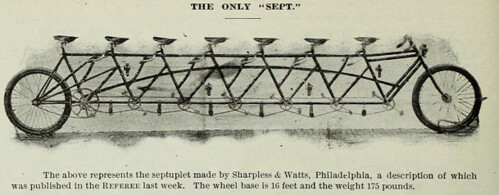At about 22 seconds the American Memory footage from 1905 starts, ending at about 40 seconds
The piece is about a town in England where they are implementing a different kind of traffic control approach, in effect reducing barriers between different types of transportation modes, including motor vehicles, bicycles, and pedestrians. They support this approach (in small part) with American Memory footage taken from "A trip down Market Street before the fire". This is an unusual set of short films created while driving down Market Street in San Francisco in 1905, before the Great Fire of 1906. It is considered valuable documentation of what the street looked like at that time.

A number of bicycles are shown riding along with the cars, horses, street cars, and pedestrians
The annotation in the LC record and the statements in the video by the British urban planners reflect different analysis of the 1905 footage. In the annotated American Memory record it states that: "The near total lack of traffic control along Market Street emphasizes the newness of the automobile. Granite paving stripes in the street marking ignored pedestrian crosswalks, making the crossing of Market Street on foot a risky venture." The British urban planners, however, regard this as the "natural order" of things that has been ruined by stoplights and that stoplights (etc) only appeared "in the last 50 or 60 years" - in order to "segrate traffic from other aspects of life."
And, as I noted, they do not identify the source of their film clip, or that fact that it was clearly orchestrated (the cars, for example, have been observed to be the same cars over and over again, apparently driving around the block and getting back into view of the filming camera to make it appear there were more cars in the city than there actually were) and likely nothing like the natural state of SF traffic at the time. The kid on the bicycle shown above, for example, looks back to regard with interest the camera shooting the film that now includes him.
Full version of the film done in 1905, originally in three parts
Bicycles appear with some frequency; the riders seem fearless as they operate near the street car.








